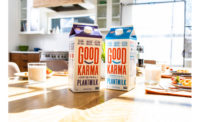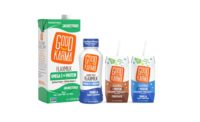Izze Beverage Co.:
Spreading Good Karma
By JOANNA COSGROVE
February 2002 kicked off a
chaotic year for Todd Woloson and his friend, Greg Stroh. Over lunch one
afternoon, the friends decided to become business partners with the idea of
crafting a line of all-natural fruit juice and sparkling water beverages
inspired by European sodas. But this venture
wasn’t just about creating a great beverage, the pair also hoped to
raise awareness and money to help struggling communities.
But before they could begin giving back, there was the
matter of securing distribution. “We’d done our first run, but
were still trying to set up a distribution meeting with a local
group,” recalls Woloson, co-founder and chief executive officer of
Izze Beverage Co., Boulder, Colo. “We were literally in the car,
driving to meet with them while the trucking company was calling, confused
about why they were loading trucks that had no destination. I told them,
‘Start heading toward Denver, I’ll have an address for you, I
promise!’”
Woloson made good on his promise and the business took
off, starting with four sparkling flavors - Pear, Lemon, Blackberry and
Grapefruit - and adding Clementine, Blueberry and Pomegranate along the
way.
Woloson says new flavor ideas originate with the
desire to produce “understandable and identifiable” fruit
flavors, but with a twist. “The interesting part is not presenting a
complex flavor profile; the excitement for us is presenting the difference
between an orange flavor and a Clementine flavor,” he says.
“The deciding factor is how well we are able to get to the true
essence of the fruit. Sometimes that’s tricky. Pomegranates,
grapefruits and lemons don’t actually taste all that good on their
own, but they have to have the right ‘soft drink-like’ mouth
appeal while maintaining loyalty to the defining fruit. Some flavors just
don’t make it because when you cook the fruits, the flavor profile
changes.”
Izze’s Sparkling beverages do not contain
caffeine, artificial ingredients, high-fructose corn syrup or refined
sugars. Instead of using preservatives, they undergo an hour-long tunnel
pasteurization process whereby filled and sealed bottles are individually
sent through sprays of increasingly hot water, until the juice inside
reaches pasteurization temperature (about 60 degrees C). The bottles are
then water cooled, gradually decreasing in temperature to prevent the
bottles from breaking.
Driven by philanthropy
While many beverage companies are preoccupied with
executing wild marketing concepts, Izze is busy partnering its energies
with non-profits groups and sponsoring non-profit events.
The non-profit group nearest and dearest to Woloson
and Stroh is their own, called the Global Education Fund (GEF). Helmed by
Woloson’s wife, GEF builds libraries and orphanages in developing
countries and is staffed and financially supported entirely by Izze. The
idea arose from a 2002 mission trip to
Honduras, where it occurred to Woloson that the economically depressed
community he was working in happened to be part of a Dole banana
plantation.
“Everyone there was part of the banana-growing
community and I was pretty sure there were similar social problems in the
communities where we were buying our fruit,” he says. “Many of
the social problems stemmed from lack of education, which is why we are
focusing on educational development in the communities where we source our
fruit. We are committed to closing this loop, literally understanding where
and from whose labor our fruit comes from.”
Izze’s dedication to helping those in need is
part of the reason why Woloson thinks the beverage resonates with
consumers. “Spreading good karma has been our priority from the
outset,” he says. “We like to think it also creates a positive
association with the brand.”
On shelf, the brand’s unassuming appearance,
created by Boulder-based TDA Advertising and Design, was designed with a
straightforward motivation. “These days, it seems the better
mousetrap is new technology and everything is getting too complex, Woloson
says. That’s why, from a consumer’s perspective, we wanted to
create an honest, but ridiculously intuitive product. Fruit juice and
sparkling water - it’s pretty hard not to understand what that is.
There’s a look and feel about the product that appeals to consumers,
too.”
Woloson said he was shocked to learn the degree to
which Izze appealed to kids, considering kids aren’t the target
consumer. “Weston Rinehart, a market research firm, did a market
research study for Ad Age, and one of the questions asked was about the ‘coolest
drink brand,’” he says. “Gatorade was No. 1, Pepsi was
No. 2 and Izze ranked No. 3 on the list. It was all very shocking to us
since we’re still pretty small.
“My hunch is that so many people are marketing
to kids, that they find products not conscientiously marketed to them
interesting,” he says. “There’s just something about the
look and feel of the bottle.”
In September Izze launched its newest package, a
12-pack of 8.4-ounce cans (in Blackberry, Clementine and Pomegranate) which are sized for lunch boxes or to pair with snacks
after school. Woloson says this format was originally developed for school
distribution but it has since taken off in Target and Tesco stores.
The company also created a newsletter to share company
goings-on with interested vendors, partners and consumers. “This
business allows us to touch so many people and distribution points and it
feels really important to share and create awareness,” Woloson says.
“If you can create a positive message around your business and
inspire people to do good things, it’s just awesome.” BI

